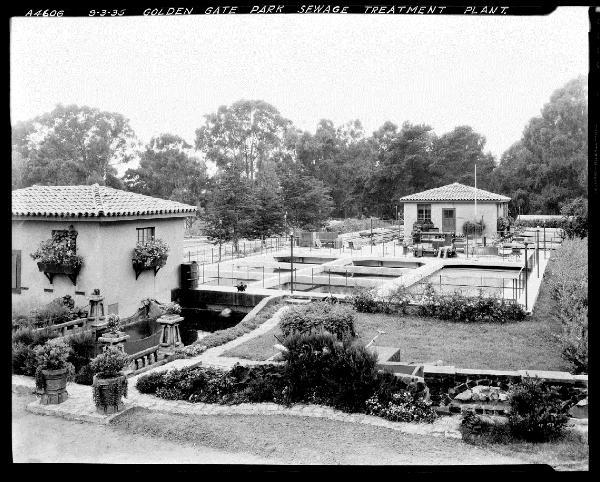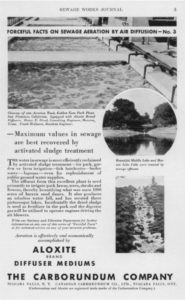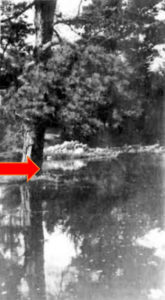
Golden Gate Park Sewage Treatment Plant – September 3, 1935 (photo by SFPUC)
The CWEA History Committee’s “Forgotten Facilities” series highlights historically significant California wastewater treatment plants that are connected to the history of our Association. So far, the treatment plants in the series have been decommissioned, repurposed, or demolished, thus the “Forgotten Facilities” title.
The wastewater treatment plants documented by the History Committee are notable for being the “first” in terms of either the application of a specific technology, the implementation of innovative programs, involvement in Association training and programs, or some combination of historical factors making the facility worth documenting. With the foregoing in mind, the Golden Gate Park Recycled Water Plant was selected for documentation by the History Committee for the following reasons:
Additionally, the Golden Gate Park recycled water plant may have been constructed through an early example of public-private partnerships, however, the record is not clear on this point.
Sewage and the Development of Golden Gate Park
The early development of Golden Gate Park from 1,017 acres of “windblown sand dunes” to a beautifully landscaped park was partly accomplished by irrigation with groundwater and raw sewage. At the start of the 20th century, famed horticulturist and Park Superintendent John McLaren used raw sewage, diverted from sewers in Fulton Street and Lincoln Way, to irrigate the western portion of the park via open ditches. Using raw sewage for irrigation was not an issue prior to the development of residential areas near the park. This irrigation practice continued until 1912, when people living near the park began to complain about the odors. The numerous and continuous complaints necessitated the construction a septic tank to remove the solids and reduce the odors. The septic tank effluent, combined with groundwater, was then used “to fill and maintain a series of ornamental lakes and to irrigate about 250 acres.”1
Irrigation of the western portion of Golden Gate Park with septic tank effluent continued until 1931, when a law suit forced the abandonment of the practice.2 The San Francisco Board of Parks Commissioners began considering the use of treated secondary effluent for irrigation as early as 1926 due to the high cost of water from the public supply and the inadequacy of the groundwater supplies.3 When irrigation with septic tank effluent ceased to be an option, the alternative of using secondary effluent for Golden Gate Park became feasible.
The McQueen Plant
Starting in the 1920’s, the San Francisco Board of Parks Commissioners (Board) and staff recognized that an alternative source of water was needed to irrigate Golden Gate Park and supply its ornamental lakes. In 1926, the Board retained the services of Henry E. Elrod, a consulting engineer from Houston Texas, to design a treatment plant to reclaim water for Golden Gate Park using the activated sludge process. Elrod, who held several patents for wastewater treatment processes and equipment, appears to have been well-versed in the activated sludge process based on his knowledge of the process from his reviews of the first activated sludge plant in the U.S. (San Marcos Texas, 1916) and his plant design work. Henry E. Elrod submitted his plans and cost estimates for the plant to the Board in October of 1926, however, the approval for construction of the plant was delayed until 1931 (possibly prompted by the elimination of septic tank effluent for irrigation in the same year).
On June 4, 1931 the Board authorized Park Superintendent John McLaren to bring the plans and updated cost estimates for the new plant for Board consideration. On September 2, 1931 Frank McQueen, representing the McQueen Sewage Disposal Company, submitted a letter to the Board offering to construct a 1.0 mgd treatment plant using Elrod’s plans. Subsequently, on November 19, 1931, the Board approved the construction of the new plant by the McQueen Sewage Disposal Company, conditioned on securing approval of the plans and specifications by the Department of Public Health for the City and County of San Francisco. In the same action, the Board authorized a not-to-exceed expenditure of $36,000 in park funds for the construction of the plant (approximately $551,000 in 2018). Thus, the new plant became known as the “McQueen Plant” based on the McQueen Sewage Disposal Company’s involvement in its construction.
A central location in Golden Gate Park was selected for the McQueen Plant (see Figure 1). This allowed sewage to be diverted from the Lincoln Way sewer main via a structure near Twentieth Avenue and permitted the plant effluent to be easily distributed to the lakes within the park. With the location selected and approved, plant construction started in April 1932 and was substantially completed by August 1932. Contemporary journal articles state that the plant was built with “relief labor”, possibly using Emergency Relief Act construction funds. This would make sense as later (1938) estimates for construction of the plant state that the total cost was around $85,000 (approximately $1.4 million in 2018 – this includes the cost of an additional primary clarifier added in 1936).4
Plant Description
The McQueen Plant was described as a conventional activated sludge plant and its main features consisted of the following:
Figure 2 provides a plan view showing the main features of the plant as constructed in 1932 and Figure 3 show the aeration basins, laboratory, and chlorinators.
Initially, the plant was originally equipped with one primary clarifier and three sludge drying beds. In 1936, one primary clarifier was added to the plant and an additional drying bed was added later.
Portions of the two below-grade digesters were underneath the blower/laboratory building (see Figure 4 for more detail). Per journal advertisements, dried sludge was used as fertilizer for the park and methane gas from the digesters was intended to be used as fuel for an engine to operate the plant blowers, however, there is no indication that this plan was implemented (Figure 5).

Figure 5. 1933 Sewage Works Journal Advertisement Showing the Golden Gate Park & Plant Mentioning Henry E. Elrod (Consultant) and Frank McQueen (Resident Engineer)
Plant Operation and Performance
The tributary area for the McQueen Plant was almost entirely residential, with a limited business section and two large hospitals. The plant influent suspended solids averaged 250 mg/L with the BOD’s in the 350 mg/L range
For several years after start-up, the McQueen Plant’s average production and delivery of recycled water was about 500,000 to 550,000 gallons per day with peaks of 750,000 gallons per day.5 The later addition of a second primary clarifier, increased aeration, additional plant improvements in 1949, and improvements to the recycled water distribution system in 1947, allowed the plant to increase its average production closer to its 1.0 mgd capacity.
The plant generally operated from mid-February to November (irrigation season) and sometimes was operated into December.6 Plant operation was completely manual (including chlorination), and 3 operators were required during the day and one operator at night to staff the plant.7
By 1951, the McQueen Plant digesters and drying beds were no longer used – waste activated sludge, along with oil and grease, screenings, grit, and primary sludge were simply discharged to the sewer line adjacent to the plant to be treated at the Richmond-Sunset Wastewater Treatment Plant (on the western end of Golden Gate Park). The lack of issues related to solids handling permitted the plant operators to focus on producing a high-quality plant effluent for park irrigation.8
After clarification, the primary effluent and return activated sludge were mixed in a pre-aeration chamber and aerated with diffused air in 10 feet deep baffled aeration basins (Figure 3). The diffusers were set at a depth of 3.5 feet, thus spiral flow throughout the depth of the aeration basins was not achieved. Also, the connection between the two basins (Figure 3, Aeration Chambers #1 and #2) used to transfer mixed liquor was located near the water surface and most of the solids were retained in the first aeration basin. Air that was supplied to the bays in the second aeration basin was half that of the air supplied to the first basin to create tapered aeration.
The secondary effluent was chlorinated at a dosage of 18 to 25 mg/L, with a minimum contact period of 20 minutes, and the effluent chlorine residual was maintained at 2.0 mg/L. The final effluent quality was very good with suspended solids around 10 mg/L and BOD’s of 5 to 10 mg/L. The coliform counts were less than 2.2/100 ml (from 1973 data).
Plant Oversight
In 1932, wastewater treatment plant permits, review of designs and plans, inspections, and the enforcement of regulations were administered by the State Department of Health, Bureau of Sanitary Engineering (Bureau). The McQueen Plant was a unique facility in 1932 – it did not go through the Bureau for review, permitting, and monitoring because there was no effluent discharge to “Waters of the State.”
Records from the 1930’s show that the McQueen Plant was operated by the San Francisco Recreation and Parks Department and that it fell under the jurisdiction of the Department of Public Health for the City and County of San Francisco (Health Department). The Health Department monitored and inspected the McQueen Plant for the first decades of its operation. The Health Department sampled and tested the plant effluent on a regular schedule to ensure it met what was termed “drinking water standards”.
According to an interview with Chester G. Gillespie (Chief of the Bureau from 1915-1947), the Bureau considered the design of the McQueen Plant to be good but was not involved in any way with the McQueen Plant.9 Interestingly, Gillespie stated that the Bureau (in the 1930’s) viewed an approval of the McQueen Plant and the use of recycled water for park irrigation as a bad precedent because the widespread use of recycled water (based on Bureau approval) could be “pretty badly abused and become a danger”, due to public contact with the water.

Figure 6. McQueen Plant Effluent Discharge to Metson Lake – Red Arrow Indicates Point of Discharge (F. Giusto, 1933)
Use of Effluent in Golden Gate Park
From 1932 to 1947, the effluent from the McQueen Plant was used primarily for maintaining the water levels in the lakes, brooks, waterfalls through its discharge to Metson Lake (Figure 6). Direct irrigation of the western portion of the park was practiced occasionally via temporary irrigation ditches with laterals. The Golden Gate Park Polo Fields/Stadium area was irrigated by a pressure pipe from the McQueen plant that was connected to a hose and could be connected to sprinklers.10
A pump and discharge line were installed to Elk Glen Lake in 1947 and Elk Glen Lake became the McQueen Plant reservoir. This made it possible to pump treated effluent directly into the park irrigation system, or to the park reservoir on top of Strawberry Hill, allowing a limited amount of effluent to be pumped with groundwater to the northeast areas of the park.11 By 1947, all areas of Golden Gate Park could be irrigated with recycled water from the McQueen Plant, except for the Lindley Meadows area which was served by the public water supply via a separate park distribution system.
By 1973, with plant improvements, the average volume of groundwater and recycled water used by Golden Gate Park was estimated to be 0.72 mgd and 2.0 mgd respectively (Mallik, 1973) and the plant effluent was irrigating approximately 800 acres. However, even with the increased use of recycled water, it was noted that groundwater levels in the eastern portion of the park were declining.
Plant Decommissioning
Changes in state regulations for the use of recycled water during the late 1960’s and 1970’s impacted the continued use of the McQueen Plant and eventually led to its decommissioning. In 1968 the “Statewide Standards for the Safe Direct Use of Reclaimed Water for Irrigation and Recreational Impoundments” were enacted. These standards were directed at the control of pathogens and set the stage for subsequent regulatory requirements for the use of recycled water. In 1975 the standards were revised to require new treatment reliability features, such as alarm systems, emergency backup power, duplicate treatment units, and standby replacement equipment at water reclamation plants. Finally, in 1978, changes were made to the regulations that required the use of coagulation, flocculation, clarification, and filtration, in addition to oxidation and disinfection, for treating recycled water used for irrigating city parks. These changes to the regulations requiring higher standards of treatment for recycled water finally forced San Francisco to decommission the McQueen Plant in 1982 due to the cost and difficulty in retrofitting the plant for compliance (note: some sources state the McQueen Plant closed in 1978, however this might be due to misinterpreting the date of the plant closing as the date of the adoption of the regulations that forced its closing).12
The closing of the McQueen Plant meant that Golden Gate Park had to depend on groundwater and the municipal water system to meet its irrigation needs. Approximately two-thirds of the irrigation demand was met by groundwater and one-third by the municipal water supply after the McQueen Plan closure.13
Repurposing
Thanks to its central location and available space, the McQueen Plant site and its buildings were repurposed in the 1980’s to become the Recreation & Park Department’s Urban Forestry Center. The old plant clarifiers, aeration basins, and chlorine contact basin were filled in and paved over. According to Kelly Cornell of the San Francisco Recreation & Park Department, the McQueen Plant buildings are still in place and are being used (see Figures 7 and 9). The McQueen Plant facilities have been repurposed for offices, employee lockers, employee training, vehicle and equipment storage, a saw shop, and employee parking.
Figure 8. McQueen Plant 1933 (Compare to 2018)
The Return of Recycled Water in Golden Gate Park – 2021
The value of recycled water for irrigating Golden Gate Park was clearly demonstrated by the McQueen Plant and in 1988 planning for the return of recycled water kicked off with the adoption of the Golden Gate Park Master Plan. The planning culminated in January 2018 with the groundbreaking for the new Westside Enhanced Water Recycling Project.
The new $214 million-dollar recycled water treatment plant is being constructed at the existing Oceanside Water Pollution Control Plant site. The new plant will use up to 4.0 mgd of secondary effluent from the Oceanside plant and treat it to meet state standards using membrane filtration, reverse osmosis and ultraviolet disinfection.14
The Westside Enhanced Water Recycling Project includes almost eight miles of new recycled water pipeline which runs through Golden Gate Park. The project also includes a pump station that will deliver recycled water to the Lincoln Park Golf Course and the Presidio Golf Course. Most of the recycled water will be used by Golden Gate Park and an 840,000-gallon underground reservoir is being built in the park to facilitate the delivery of water to Golden Gate Park and the golf courses.
Construction of the Westside Enhanced Water Recycling Project is scheduled to be completed in 2021, marking the return of recycled water to Golden Gate Park after an absence of nearly 40 years.
Acknowledgements
The CWEA History Committee wishes to acknowledge and thank Mr. Kelly Cornell and Mr. Dennis Kern, SF Recreation & Park Department staff, for their assistance in providing background information and photographs of the Urban Forestry Center. The Committee also wishes to thank the San Francisco Public Library, Government Information Center, for access to illustrations from the 1933 Frank Guisto student thesis on the McQueen Plant.
(1) Ongerth, Henry J. and William F. Jopling (1977). Water Reuse in California. In Hillel Shuval (Ed.), Water Renovation and Reuse (pg. 233), New York: Academic Press Inc.
(2) United States Environmental Protection Agency, EPA 403/9-73-006 (1973). Survey of Wastewater Facilities Using Land Application of Wastewater, Golden Gate Park (pg. 202), Washington D.C: Office of Water Program Operations.
(3) Hyde, Charles Gilman (1937). The Beautification and Irrigation of Golden Gate Park with Activated Sludge Effluent, (pg. 929), Sewage Works Federation Journal, Vol. 9, No. 6, Nov. 1937.
(4) Hyde (pg. 936).
(5) Gieger, J.C. (1941). Beautification and Irrigation of Golden Gate Park with a Clarified, Disinfected Sewage Effluent (pg. 91), California and Western Medicine, Vol. 55, No.2, August 1941.
(6) USEPA (1973). Wastewater Treatment and Reuse by Land Application: Volume 2, (pg. 204), Washington D.C., USEPA.
(7) USEPA (1973). Wastewater Treatment and Reuse by Land Application: Volume 2, (pg. 203)
(8) Martin, Benn (1951). Sewage Reclamation at Golden Gate Park, Sewage and Industrial Wastes Journal, Vol. 23, No. 3, (Pg. 320)
(9) Gillespie, Chester G., Malca Chall, Henry J. Ongerth, (1970). Origins and early years of the Bureau of Sanitary Engineering: transcript, (pg. 13), U.C. Berkeley, Regional Oral History Office, Bancroft Library.
(10) Hyde, (pp. 940-941).
(11) Martin, (Pg. 320).
(12) Royston, Hanamoto, Alley & Abbey (1998). Golden Gate Park Master Plan, (pg. 2-12).
(13) Royton, (pp. 2-12, 2-13).